If you love Chả Lụa (Vietnamese Pork Roll) , you will definitely love Giò Sống . This pork paste is a basic ingredient in Vietnamese cuisine. Making Giò Sống at home is much easier than you think, even with just a mini food processor.

What is Giò Sống?
Giò is how we call Chả Lụa in the North, and Sống means raw, so giò sống means raw pork paste. After steaming, it will become Chả Lụa.
For those unfamiliar with Vietnamese cuisine, it’s similar to the pork paste used to make luncheon meat or a finely textured sausage like Italian Mortadella.
For German-speaking people, giò sống is quite identical to fresh raw Fleischkäse found in German supermarkets, but it’s seasoned with fish sauce.

Giò sống has a lightly bouncy and springy texture, quite similar to bò viên (beef meatballs), chạo tôm (sugar cane shrimp) or nem nướng (sausage skewers).
You can easily find giò sống in any supermarkets and wet markets throughout Vietnam. Overseas, if you live in a neighborhood with a large Vietnamese community, you might find giò sống at a nearby Asian market. Unfortunately, it’s not very popular in Germany.
Ingredients

- Ground pork: This is the easiest way to make Vietnamese pork paste since I will use ground pork. Choose the meat as fresh as possible. The fresher the pork is, the easier and more successful the chance of making it.
- Fish sauce: Fish sauce is the soul of Vietnamese cuisine.
- Baking powder: This is a key ingredient. You could use Alsa or Dr. Oetker baking powder. Make sure your baking powder is still active.
- Starch: You could use potato starch, cornstarch, or tapioca starch. I use potato starch in my recipe.
- Onion powder or garlic powder: In Vietnam, we use fresh garlic and shallots, but this is my shortcut.
- Cooking oil: There is typically a percentage of fat in giò sống, as well as in any kinds of sausage.
- Other seasonings like salt, chicken powder, and sugar.
Imporant Notes
The crucial point to remember here is to ALWAYS keep your meat CHILLED.
The most important thing in making Giò Sống (and all other types of sausage) is that the meat always remains COLD. The so-called protein extraction process binds the meat and spices to create an elastic, springy texture – this works best at temperatures between 39°F and 44°F (or 4°C and 7°C).
- If you’re preparing it in 2-3 batches, keep the next batches in the fridge, and ensure the ready batch of giò sống is also refrigerated.
- There should always be condensed water on the outside of your work bowl. If not, stop immediately, place the bowl with the meat in the fridge for 30 minutes before continuing.
- If possible, chill your work bowl in the freezer for 15 minutes.
- Avoid overworking your food processor: It can lead to the failure of your pork paste batch, especially when the motor is located at the bottom and comes into direct contact with the pork paste. If the food processor’s motor becomes too hot, stop immediately and refrigerate the bowl with the meat until the food processor cools down and can resume working.
- If you have a meat thermometer, use it. If the temperature of the pork paste exceeds 41°F (5°C), stop working and refrigerate the bowl with the meat for 20-30 minutes.
Storage

You can divide the pork paste into small portions for your daily meals and store them in the freezer.
Pork Substitutes
If you avoid pork, ground chicken or turkey can be used instead. Don’t use ground beef, as it has a strong and distinct flavor.
How to use Giò Sống
Giò Sống is a versatile ingredient in Vietnamese cuisine.
Base for Vietnamese-style sausages:
Vietnamese noodle soup:
Canh (Vietnamese light soup):
Stuffing & Meatballs:
FAQs
More authentic Vietnamese recipes

(Vietnamese Sizzling Pancakes)

(Cà Phê Sữa Đá)

(Vietnamese Sweet & Sour Soup)

How to Make Giò Sống (Vietnamese Pork Sausage Paste)
Equipment
- 1 Food Processor (or 1 stand mixer with the flat beater attachment)
Ingredients
- 1 pound ground pork (450g)
- 1½ tbsp fish sauce
- 1 tsp chicken powder
- 2 tsp sugar
- 2 tbsp potato starch (tapioca starch, cornstarch)
- 3.5 tbsp cooking oil
- ½ tsp baking powder (Alsa or Dr. Oetker)
- ½ tsp garlic powder (or onion powder)
- 4 tbsp water
Instructions
Prepare the meat:
- In a bowl, combine the ground pork with all the other ingredients by hand. Don't mix for too long since your hand's temperature could heat the pork mixture.
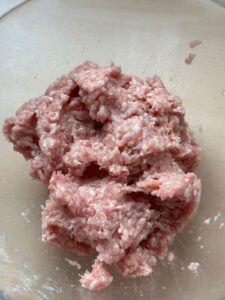
- Transfer the mixture into a freezer-safe plastic bag or a metal baking tray.. Spread the mixture evenly to form a pork patty about 0.4 inches (1 cm) thick.
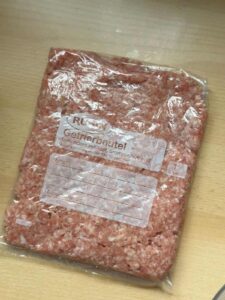
- Leave the bag of meat in the freezer for 3-4 hours until it's semi-frozen. If you can't make your Giò Sống on the same day, leave it in the freezer. Before grinding, allow it to sit at room temperature for 1-1.5 hours until it reaches a semi-frozen state.
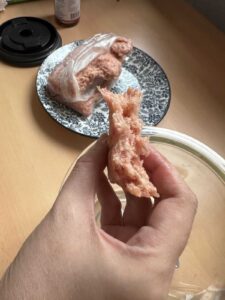
- Before grinding the meat, use scissors or a knife to cut the semi-frozen pork patty into pieces.
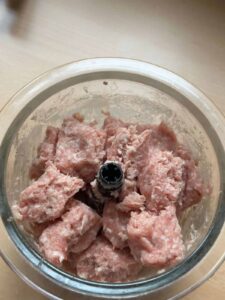
With a food processor (for a small batch of 0.4-0.7 pounds or 200-300 grams, my food processor is 800W)
- Pulse at the lowest power to grind the pork. After 2-3 pulses, scrape the sides of the bowl and push any meat that's stuck to the blades.
- Once you've pulsed around 10 times, you can increase the power level and pulse for 7-10 seconds. Be sure to stir the meat and scrape the bowl occasionally.
- When the paste appears smooth, paler, and fluffy, it's ready. When you use a spoon to scoop the pork paste, it should stick to the spoon.
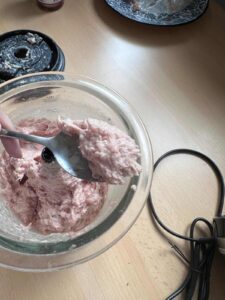
- Transfer the first batch of pork paste to a bowl and continute with the remaining meat.
- To enhance the elasticity and springiness of your pork paste (optional), you can "knead" it using the following method, which my mom taught me: Use a spoon to whisk the pork paste, spreading it to the sides of the bowl. Repeat these steps for about 10 minutes.
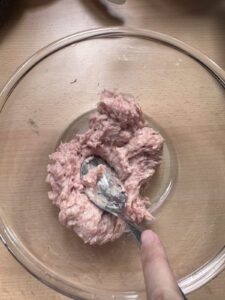
With a stand mixer (for a larger batch of 1.1-1.7 pounds or 500-800 grams)
- Beat the pork mixture on the lowest speed for 2 minutes.
- Beat the mixture on medium speed for 3-5 minutes.
- Finally, increase to the highest setting and beat for another 3-5 minutes.
- The paste is ready when it looks smooth, paler, and fluffy. When using a spoon to scoop the pork paste, it should cling to the spoon.
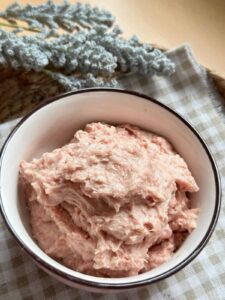
Notes
- If you’re making it in 2-3 batches, store the next batches in the fridge, and ensure that the ready batch of giò sống is also refrigerated.
- Condensed water should always be present on the outside of your work bowl. If it’s not, stop immediately and place the bowl with the meat in the fridge for 30 minutes before continuing.
- If you can, chill your work bowl in the freezer for 15 minutes.
- Don’t overwork your food processor, especially when its motor is at the bottom and in direct contact with the pork paste. If the motor becomes too hot, pause immediately and refrigerate the bowl with the meat until it cools down and can continue processing.
- You could use a meat thermometer to monitor the temperature of the pork paste. If it exceeds 41°F (5°C), pause and refrigerate the bowl with the meat for 20-30 minutes.

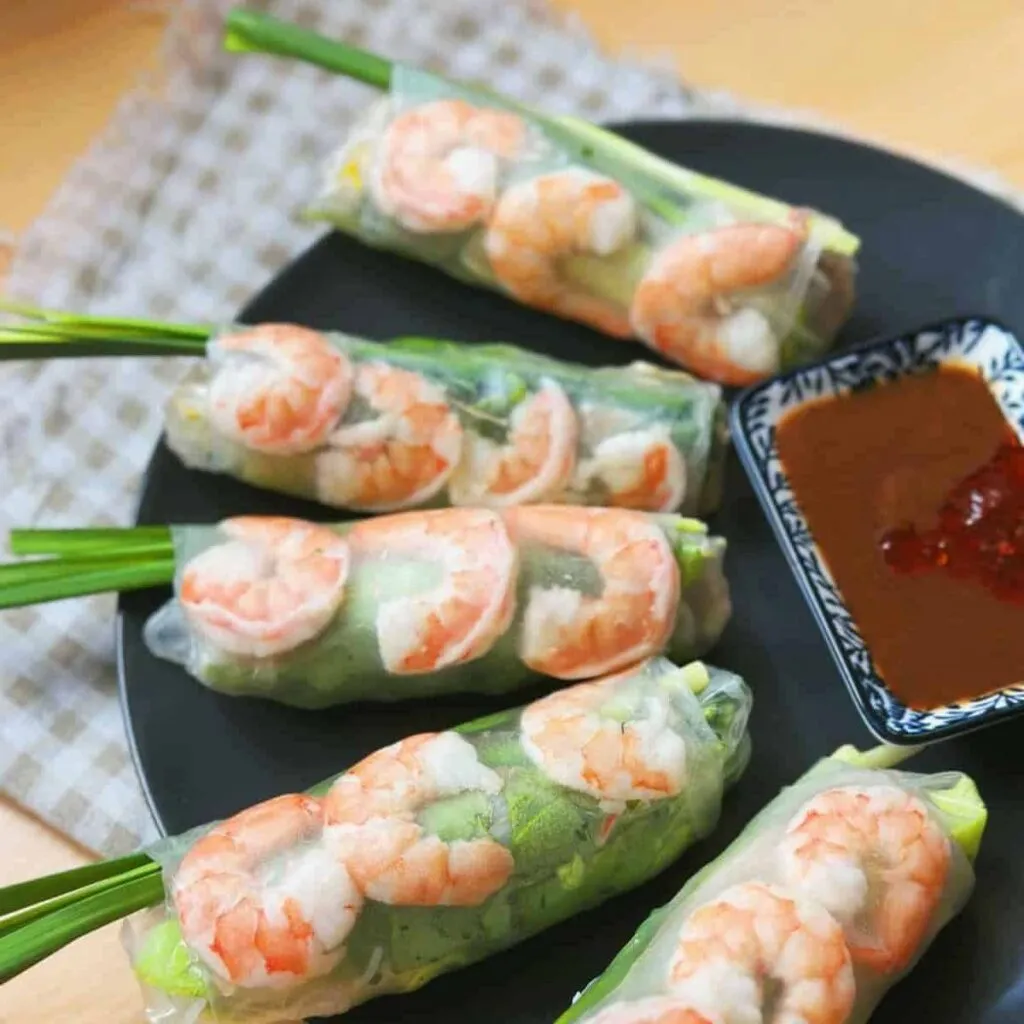
Wonderful! Worth the effort and the clear recipe was easy to follow. I used this paste to make meatballs with wood ear fungus – they were delicious. Having a really cold kitchen probably made it easier as the paste didn’t heat up so easily. I’ll be making this again!
Thank you so much for your feedback !!!